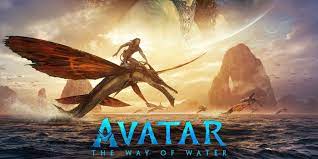‘Avatar: The Way Of Water’ Should be Experienced in Theaters
Movie Review
December 23, 2022
After watching 2009’s “Avatar,” I thought there would be no way James Cameron could produce a sequel that would wow me the way the same way. With its impressive CGI for the time, the first movie was like nothing I’d ever seen before, and I thought nothing would ever compete. So, when I learned of the sequel I didn’t think anything would top that very first experience. Nevertheless, “Avatar: The Way of Water” exceeded all of my expectations.
The film is three hours long, but despite the long runtime, it never felt like a chore to sit through, unlike other blockbusters (“The Batman”) released this year. While watching “Avatar: The Way of Water,” I felt that the pacing of everything went together perfectly and created a well-rounded story and experience.
“Avatar: The Way of Water” is by far the most visually stunning movie I have ever seen. The majority of the movie is captured by CGI, but it looks as if the Na’vi, the natives of Pandora, are real and not motion-captured humans. This is no surprise considering the new motion-capture technology designed specifically for Avatar captures the actor’s precise movements underwater. This movie experience is so heavily enhanced by the big screen that I would not recommend watching it on Disney+ if you can help it. “Avatar: The Way of Water” is a movie you need to experience inside the theaters.
The audience is welcomed back to Pandora, where we once again follow Jake Sully (Sam Worthington) fifteen years after the events of the first movie. Sully now has a family of his own with his wife Neytiri (Zoe Saldana) and their four children Neteyem (Jamie Flatters), Lo’ak (Britain Dalton), Tuktirey (Trinity Bliss), and Kiri (Sigourney Weaver). The CGI required to make a seventy-three-year-old woman appear as a fourteen-year-old teenager should be all I need to say to tell you to watch this movie. In addition to their four children, Jake and Neytiri are also raising Spider (Jack Champion), a human boy left on Pandora who grew a close attachment to the Sully clan.
The character who stood out to me the most was Lo’ak, Sully’s youngest son. Amongst the younger cast, Dalton’s acting shined through. Lo’ak’s features are human-like, having five fingers and eyebrows, which is considered alien to the Na’vi, making him the outcast of the group. This causes him to clash with his older brother Neteyam, who he considers perfect in appearance and attitude, and his own father whom he looks up to immensely for being known as a great warrior amongst their people.
Throughout the movie, Lo’ak struggles with these internal issues but is able to overcome them and find himself in the “way of water” itself. I felt as if I was viewing a real family going through their issues. The relationship between the family themselves and how they interacted with each other seemed genuine and sincere. If I didn’t know any better, I would imagine that all of them were truly related.
Due to the return of the RDA and Quaritch, the villainous colonel from the previous movie who’s out for revenge against Jake and his entire family, the Sully family is forced to leave their home in the forest and seek asylum with the Metkayina clan, a Na’vi clan based in the sea, to protect their family from harm. With the Metkayina, the Sully family fosters new relationships, and along with the clan values, they also learn the way of water. The way of water is a path that the Metkayina clan follows, which not only instructs them on how to hold their breath for a long time long but is an idealogy they hold about life itself.
The Sully family remains with the Metkeyina clan, and while Jake learns from its leader Tonowari (Curtis Cliff), the children learn from Tsireya (Bailey Bass) and Aonung (Filip Geljo), the children of the clan leader. This peace however only lasts for so long until Quaritch finds his way to the clan, and they’re forced to fight for their family and the Metkayina clan.
One of the main takeaways from this movie was the concept of the way of water. In the first movie, you follow Jake learning the way of the forest and how Na’vi is connected with Ewya through nature, but “The Way of Water” takes it a step further. The Metkayina clan stress that the water is around you and within you, following you throughout your life from your birth and even after your death. To me, this was the most moving and emotional part of the movie, and it’s the element that stuck with me even after I left the theater.
The Metkayina clan are Na’vi who are adapted to live in the water. Their bodies are made to be in ocean environments in comparison to Omatikaya, who are more adapted to be in forest environments. One of the main themes that is repeated throughout both films is the connection between Na’vi and nature. The bond they form with the animals and nature is both emotional and spiritual. The Metkayina clan is connected with an animal know as the Tulkan, which are sentient beings similar to whales, and the bond between them runs so deep, they are considered siblings. Additionally, because of this deep connection between the Na’vi and nature, it’s a common belief that when you die, your spirit is returned to Eywa, a sentient life force within Pandora that the Navi acknowledges as a deity. It’s recurrent in the story and provides the Na’vi comfort with the idea of loss. Even though death is a tragic occurrence, the movie sends the message that your loved ones are always with you within the sea, and with Eywa, herself.
This level of connection to nature, extending not only to the forest but to the sea as well essentially captured the message of this movie and helps the audience understand the connection between the Na’vi and Ewya.
“Avatar: The Way of Water” is not only a movie but an experience that everyone should get to have. The time, effort, and acting ability that went into making this movie are conveyed in full and leave you wondering about the next sequel. This movie will be the talk of the year, and I wouldn’t be surprised if its theatrical run is extended within the new year.



